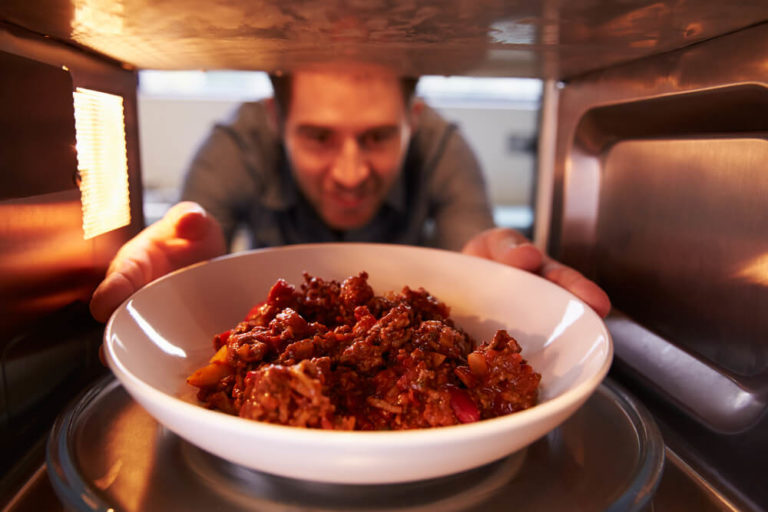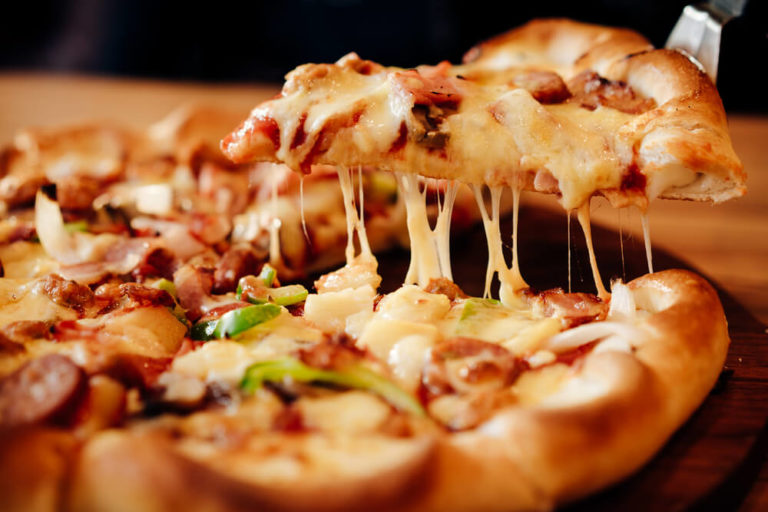Whether it’s leftovers or to-go orders, we’re always on the lookout for clever ways to make our food go further. Reheating food in the oven isn’t something to overlook. If you fail to reach the correct temperature or use the proper techniques could result in a soggy meal or, even worse food poisoning, an unpleasant illness that puts you out of action for a few days. The bacteria either multiply astronomically or they produce poisons that can cause illness which can even be life-threatening. Based on the latest estimates we found 2.4m foodborne illness cases per year and the total burden for the UK is approximately £9bn from these. Reheating and cooling in the right way and ensuring food is at the correct temperature before eating can help you prevent this sort of illness and get the natural nutritional content and flavour of your meal.
Table of Contents
Essential Things to Know about Reheating Food in the Oven
Did you know every year we buy approximately 10 million turkeys, and yet we throw away over 100,000 tonnes of poultry where most of it completely edible? Reheating foods saves not only money and time but also reduces waste. It is an important practice if you prepare foods in bulk or order more than you need.
Additionally, some reheating methods can make certain leftovers far less appealing to eat. In this article, we are going to discuss some essential things like what we can reheat, the right temperature for reheating, how many times we can reheat it and before reheating food in the oven and also some different food reheating techniques.
1. What temperature to reheat food in oven?
To reduce the risk of contamination and ensure all the harmful bacterias are killed, it’s crucial to reheat your food until it’s piping hot all the way through. Ideally, you should use a thermometer to check that your food is thoroughly reheated. To avoid all the guesswork, stick the instant-read probe into the thickest part of the food.
The Food Standard Agency of the UK recommends cooking food until it has reached 70°C for a minimum of two minutes. You can also cook your food for 45 minutes at 60°C and 10 minutes at 65°C.

The other time and temperature combinations are:
- 60°C for 45 minutes
- 65°C for 10 minutes
- 70°C for 2 minutes
- 75°C for 30 seconds
- 80°C for 6 seconds
2. Can you reheat food more than once?
Ideally, you should eat food straight after it has been cooked. This is when it’s most likely at its freshest and taste the best. When reheating food, it should reach a temperature of at least 75 °C. Try to heat the oven as per the original cooking instructions. Depending on the food this is typically going to be between 160 °C to 220 °C for a domestic oven. Try not to reheat food more than once as it lost taste appeal as well as nutritional contribution. Reheated food should be served immediately, and any leftovers should be thrown away.
3. How to properly reheat food in the oven?
The general rule of thumb is to reheat food in the same way it was originally cooked. For example, a roast chicken should be reheated in the oven; the soup should be reheated in a pot on the stovetop.
To make sure that foods like roast meats and casseroles do not dry out while reheating, you may need to cover them with aluminium foil. Though the reheating time varies depending on the food, you should use a low temperature and cook until the dish is heated through (70°C for at least 2 minutes).
There is disbelief to the popular belief that it’s not necessary to preheat the oven when reheating the food. It can actually be beneficial to allow the leftovers to warm up alongside your oven, especially when the container comes straight from the fridge. If you want to maintain proper moisture in your food, make sure you reheat them slowly and cover with foil. If possible stir halfway through
4. What foods can not be reheated?
Ideally, you should never reheat food which has been stored for more than two days or left at room temperature for longer than two hours. You should defrost the leftovers from the freezer thoroughly and reheat within 24 hours,
5. How to reheat in the microwave?
In a microwave oven reheating food can get tricky as you might notice that the centre of your food takes longer time to warm. Form your dish into a ring shape or place your container onto the turntable off-centre in order to ensure it reheats properly. If possible, pop a cup of water into the microwave as well to prevent the dry out of the food. Just keep in mind that it might take the reheating process long, also beware of the boiling water.
6. Be careful with the rice
While all types of food should be safe to eat if stored and reheated properly, you can get food poisoning from eating reheated rice if not the rice has been stored properly. Uncooked rice contains “Bacillus Cereus” named spores of bacteria, which can survive being cooked. So, always check it’s steaming hot all the way through.
Leftover rice should be cooled and stored in the fridge as soon as possible and kept no more than one day. And if the rice is from a takeaway, make sure it has been handled if you are planning to eat some later—the best way to eat immediately as it is likely to have been pre-cooked and reheated once already.

7. Try to avoid overcooking
Keep in mind that heating food properly is a good practice, and you need to heat foods of similar density or texture at the same time. Do not heat different foods at the same time as a large piece of meat will take much longer time to reheat than a stalk of broccoli, which can cause overheating and even ruining the dish. Add necessary ingredients to the plate one at a time, starting with the dish that takes the longest period to reheat.

Different food, different method
Different food has a different texture and density so that there are different methods of reheating them in the oven. You can not reheat vegetables as chicken, the heating temperature of pasta will not be the same as lasagne.
Fish
There is nothing worse than overcooked fish. Heat fish dishes in a low-temperature oven until just heated through.
It is so easy to overcook fish when reheating it and there is nothing worse than overcooked fish. You should cook it until the internal temperature is between 54°C and 63°C (130°F and 145°F). Whitefish is best recooked in a sauce to keep it moist, or wrapped loosely in foil and reheated in a low oven whereas thin, breaded fish is best reheated under the grill. The fish should easily flake when touched with a fork, at its best.

Pizza
 If you are going to reheat a whole pizza, stick it in the oven directly on the oven rack.
If you are going to reheat a whole pizza, stick it in the oven directly on the oven rack.
And if it is just reheating a slice or two, warm it up in a hot skillet with the lid on. This stovetop technique will give you a crispy crust with melty cheese on top. You need to heat until the tomato sauce is piping hot and the cheese is oozing!
Chicken
You can reheat roast chicken as a part of a new dish such as curry or risotto. Always ensure it is hot all the way through, the internal temperature should be of at least 74°C (165°F). In an oven, you can also cover it with aluminium foil and reheat it.

Mashed Potatoes
Before popping your food in the oven, you need to lay it out flat in the bowl or plate, ensuring a similar thickness throughout. Reheating items like mashed potatoes is a bit tricky. This will help the heat to travel through the food evenly.

Lasagne
You can reheat lasagne in the oven covered loosely with foil and baked at 160°C (320°F) until it gets hot throughout. You can also reheat it with plastic wrap in the microwave for quicker results. Remove the foil in the final stage to crisp up the top.

Fried foods
It is much easier to reheat fried foods in the oven as they have the best chance of getting crispy again in dry heat. It’s best to place them in a preheated oven and put them on top of a rack, so the item does not simmer in any excess grease.
Pasta
Reheat pasta and sauce using a microwave-safe dish. Flatten out the pasta, so it has an even thickness, cover with cling film (plastic wrap), set the microwave to 50% power to avoid overcooking, and cook for three to four minutes depending on the serving size. If your pasta has a particularly generous amount of sauce, it may be easier to cook it through on the hob. Check the dish is hot all the way through before eating.

Some additional tips
1. You should not defrost food at room temperature. It is best to leave to thaw in the fridge overnight because bacteria thrive when temperatures climb above 8°C (46.4°F). You can also use the defrost setting on your oven if you are short on time. There are different methods of freezing between fruits and Thanksgiving turkey.
2. Sometimes you need to cut your food into small and equally sized pieces to help the reheating process more quickly and evenly. Bite-sized pieces will definitely take less time to reach a safe temperature than big chunks.
3. Take your sweet time to reheat your favourite food as reheating slowly helps retain its flavour and texture. Foods that should be crisp (such as the skin on a jacket potato or golden breaded chicken) reheat best on a lower temperature in the oven – around 170°C (340°F) should do the trick. Do not wrap these foods too tightly in foil; otherwise, water will become trapped, making your food soggy.
4. Before reheating rice in the microwave, drop an ice cube into it. This will help keep the grains moist when recooking. Make sure it is piping hot throughout before serving and serve immediately. Cooking rice perfectly is an art and you need sheer patience and dedication to do so.
5. You should always check food labels in case they include any instructions for reheating later. Follow them carefully if they do. Stir throughout heating if required, especially to avoid cold spots in sauces and soups and allow the food to stand if instructed.
Related:
1. 7 Steps to Create Your Own Fitness and Diet Plan
2. Healthy Food List: Top 50 Weight-Loss Friendly Foods
3. What Foods Can You Freeze? A Complete Guide on Freezing Food
4. A Complete Guideline to Healthy Eating Pyramid
5. 20 Healthy Foods to Eat Everyday According to Expert Advice
6. How to Lose Weight Fast: 7 Scientific Steps to Drop Weight Effectively
Bottom line
The common misconception about reheating foods is that it’s not just only warming through but cooking again. You should always reheat food until it is steaming hot throughout and serve the dish immediately after. Delay serving your food increases the risk of food poisoning astronomically, as there is time for harmful bacteria to multiply. Aim to heat up just the amount you need as it is best to reheat leftovers once. While reheating dishes for more than once may heighten the chance of food poisoning and also, reduces the nutritional content and flavour of your meal. So, make sure you use the proper techniques and ingredients to reheat your dishes and be healthy!
FAQs
1. What temperature to reheat food in oven celsius?
The recommended temperature for reheating food in the oven, as stated in the content provided by the website, is approximately 165 degrees Celsius. This temperature ensures that the food is thoroughly reheated, reducing the risk of foodborne illnesses while maintaining its quality.
2. How long to reheat leftovers in oven?
Leftovers should be reheated in the oven for a longer duration, typically ranging from 15 to 20 minutes. This allows for thorough heating of the food, ensuring it reaches a safe temperature for consumption while also retaining its flavor and texture.
3. How to reheat food in oven?
Food can be reheated in the oven by preheating it to the desired temperature, placing the food in an oven-safe dish, covering it with aluminum foil to prevent drying out, and heating until it reaches the desired temperature.
4. How to heat up food in the oven without cooking it?
Food can be reheated in the oven without cooking it by preheating the oven to a low temperature, placing the food in an oven-safe dish, covering it with aluminum foil, and heating it until warmed through. This method helps to avoid overcooking or drying out the food while ensuring it reaches a safe temperature for consumption.
5. What temperature to warm up food in oven?
Food should be warmed up in the oven at a temperature of around 350°F, as suggested by the content found on One Education.
6. What temperature to reheat food in oven uk?
Food should be reheated in the oven in the UK at a temperature of 165°F (75°C).
7. How to heat up food in the oven?
Food can be reheated in the oven by preheating it to the desired temperature, placing the food on an oven-safe dish, covering it with aluminum foil to prevent drying out, and then placing it in the oven for the recommended time until heated through.
8. How to reheat food without drying it out?
Food can be reheated in the oven without drying it out by placing it in an oven-safe dish, covering it with aluminum foil, and heating it at a low temperature, typically around 200-250°F (95-120°C), until warmed through. This method helps retain moisture and prevents the food from becoming dry.
9. Can we reheat food in OTG?
Yes, food can be reheated in an OTG (Oven, Toaster, Grill).
10. Why is using an oven recommended for reheating hot appetizers?
Reheating hot appetizers in the oven is recommended because it ensures even heating throughout the food, helping to maintain its original texture and flavor. This method also reduces the risk of uneven heating, which can lead to some parts of the food being too hot while others remain cold. Using an oven allows for greater control over the reheating process, resulting in better overall quality of the reheated appetizers.
11. What is the correct procedure for reheating food?
The correct procedure for reheating food involves preheating the oven to the desired temperature, placing the food in an oven-safe dish, covering it with aluminum foil to prevent drying out, and heating it until it reaches an internal temperature of 165°F (74°C). Once heated thoroughly, let the food rest for a few minutes before serving to allow for even distribution of heat.
12. How do you reheat meals in the oven?
Meals can be reheated in the oven by preheating the oven to the desired temperature, placing the food in an oven-safe dish, covering it with foil to prevent drying out, and then heating it until it reaches the desired temperature throughout. It is important to ensure that the food is heated evenly to avoid cold spots.
Read more
- The Impact Of Remote Work On Women In The Marketing Industry
- 5 Reasons Why You Should Pursue a Cybersecurity Career
- Differentiating Web Design and Web Development
- Top 10 Social Media Management Tools for Businesses in 2024
- Why is Child Development so Important in Early Years
- Line Management: How to be a Good Line Manager?
- How Long Should a Health Sector Career Take?







 December 08, 2023
December 08, 2023








